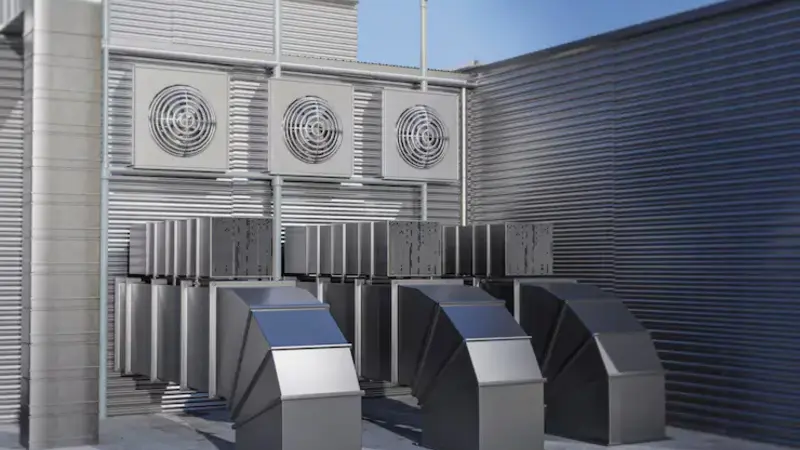Portable air conditioners
Portable air conditioners are a versatile and convenient solution for cooling specific areas in your home without the need for permanent installation. These units are especially useful in situations where traditional air conditioning systems are impractical or too costly to install.
How Portable Air Conditioners Work
Portable air conditioners work by pulling warm air from the room, cooling it by passing it over a refrigerant-cooled coil, and then blowing the cooled air back into the room. The warm air and moisture extracted from the room are typically expelled outside through an exhaust hose that fits into a window. This process not only cools the air but also dehumidifies it, adding to the comfort.
Advantages of Portable Air Conditioners
- Flexibility and Mobility: These units can be moved from one room to another, targeting cooling where it is needed most. This mobility is perfect for homes that do not require constant cooling in all rooms.
- Ease of Installation: Unlike split systems or central air conditioning, portable air conditioners do not require professional installation. Most units are plug-and-play and come with an easy-to-install window kit.
- Cost-Effectiveness: Portable air conditioners are generally less expensive than permanent air conditioning systems. They offer a practical solution for those who want to avoid the higher costs of installing ductwork or a central system.
- Ideal for Renters: Because they can be installed without altering the structure of a home, portable air conditioners are ideal for renters or those living in temporary housing.
Choosing the Right Portable Air Conditioner
When selecting a portable air conditioner, consider the size of the space you need to cool. Units are typically rated by BTUs (British Thermal Units), and a higher BTU rating indicates the ability to cool a larger area. Additionally, look for features such as multiple fan speeds, remote control functionality, and energy efficiency ratings to maximize comfort and convenience.
Maintenance Tips
To ensure optimal performance, regular maintenance is necessary. This includes cleaning or replacing the air filter, checking the exhaust hose for blockages, and ensuring the unit is level so that it drains correctly. Proper maintenance helps extend the life of the unit and keeps it running efficiently.
Commercial air conditioning
Commercial air conditioning systems are essential for maintaining a comfortable and productive environment in various business settings. These systems differ significantly from residential units in terms of size, power, and complexity. Understanding the components and benefits of commercial air conditioning can help business owners and facility managers make informed decisions about their HVAC needs.
Key Components of Commercial Air Conditioning Systems
Centralized Systems
Centralized air conditioning systems are commonly used in larger commercial spaces such as office buildings, malls, and factories. These systems feature a central unit that cools air at a single point before distributing it throughout the building via a network of ducts. This setup allows for consistent cooling across large areas.
Packaged Units
Packaged units combine the compressor, condenser, and evaporator into a single unit, usually located on the roof or near the building. This type of system is space-efficient and easier to maintain than systems with separate components scattered throughout the building.
Chilled Water Systems
In chilled water systems, water is cooled in a central location and then circulated through coils located in air-handling units throughout the building. Air blows over these coils to produce cool air. This system is particularly effective for buildings with multiple floors and varying cooling needs.
Advantages of Commercial Air Conditioning
- Enhanced Comfort: Proper air conditioning creates a comfortable environment for employees, customers, and clients, which can lead to increased productivity and satisfaction.
- Improved Air Quality: Commercial systems often include filtration and humidification components that improve indoor air quality, reducing the spread of airborne illnesses and allergens.
- Energy Efficiency: Modern commercial air conditioning units are designed to be energy-efficient, reducing operational costs. Many systems include zoning capabilities, which allow different areas to be cooled based on their specific use and occupancy, further enhancing energy savings.
Maintenance and Operational Considerations
Maintaining a commercial air conditioning system is crucial for its efficiency and longevity. Regular maintenance should include checking and cleaning air filters, inspecting ducts for leaks, and ensuring that all mechanical components are functioning correctly. Additionally, it’s important to have a professional HVAC technician perform annual check-ups to handle more complex maintenance tasks and troubleshoot any issues.
Choosing the right commercial air conditioning system involves considering the size of the space, the average number of occupants, and specific business needs such as the presence of heat-generating equipment or the need for server room cooling. Consulting with HVAC professionals can provide tailored advice and solutions, ensuring that the chosen system effectively meets the unique demands of the commercial environment.
